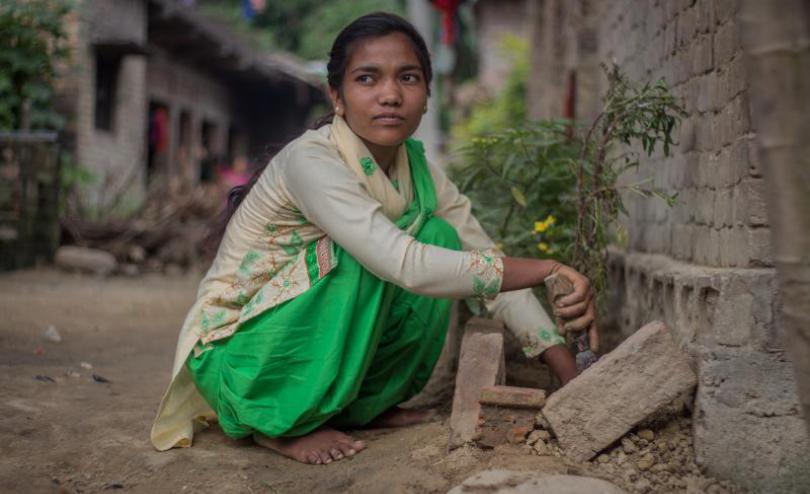International Day of the Girl: If all girls completed secondary school, more than 50 million child marriages could be prevented


Fifty million child marriages could be prevented by 2030 if all girls around the world finished secondary school, new analysis by Save the Children reveals.[i]
The critical role that education plays, and will continue to play, in reducing child marriage rates has been outlined in a new briefing, Working Together to End Child Marriage.
The relationship between child marriage and education is two-way. Child marriage is one of the leading reasons for school drop-out in low-income countries. At the same time girls who are out-of-school are exposed to increased risk factors for child marriage; with many living in insecure environments, parents often feel that that marrying their daughters will protect from harm or the stigma associated with having a relationship or falling pregnant outside of marriage.
The briefing highlights the impact that universal education could have, as well as the huge amount of progress still needed to end child marriage and ensure all girls are able to complete secondary education. In addition, it calls on world leaders to prioritise girls’ access to health and protection programmes to help end child marriage.
The briefing also reveals that:
- While an estimated 25 million child marriages have been prevented over the past decade, no developing country[ii] is currently on track to meet the UN goal of wiping out the practice by 2030[iii];
- Meanwhile, based on current trends:
- universal upper secondary school completion will not be achieved before 2084 - more than 50 years off target;
- according to the current trend, 134 million girls will marry between 2018 and 2030. Almost 10 million girls will marry in 2030 alone, and more than two million of those marriages will involve girls under 15 years of age;[iv]
- Last year, 21% of women between 20 and 24 years globally were married or in a union before the age of 18.[v]
- A recent Save the Children study in Niger - which has the highest rates of child marriage in the world - also found that girls who do not attend school are more at risk of child marriage, early pregnancy, and being malnourished.
Helle Thorning-Schmidt, CEO of Save the Children International, said that while education alone won’t end child marriage, it is a critical piece of the puzzle in ending the abusive practice.
“A toxic combination of poverty and gender discrimination means many families come to the conclusion their daughters are better off becoming wives and mothers than with getting an education,” she said.
“When a girl gets married it doesn’t just violate her rights once—the consequences last a lifetime. She is more likely to suffer abuse, more likely to become a mother before she is emotionally or physically ready, and her children are more likely to die before their fifth birthday.
“We’ve seen that a combination of education and girls’ empowerment programmes have been the most successful way to bring down child marriage rates, while cash payments while cash payments give parents the opportunity to keep their daughters in education and enrol them in school, instead of having them working in the fields to add to the family income.”[vi]
Previous research by Save the Children and the World Bank has shown that while legal and policy reform is also important in ending child marriage and keeping girls in school, so is enforcing these laws and changing attitudes at the community level.
In Nepal - home to one of Asia’s highest rates of child marriage despite being illegal since 1963 - Save the Children has been advocating and working closely with local governments, law enforcement agencies, religious leaders, communities, and girls, to raise awareness of the dangers of child marriage.
Through activities like street dramas written and performed by children, to working with religious leaders who now refuse to marry anyone under the legal age of 20, child marriage rates dropped by 11% between 2015-2017 in areas where Save the Children operates.
“This is a testament that shifting social attitudes is important, which is why we’ve made such a huge effort to work with traditional religious leaders - making them partners, rather than barriers, to change - with incredible results,” said Ned Onley, Save the Children’s Country Director in Nepal. “Two of the religious leaders we work with now make parents submit birth certificates to prove that both the bride and groom are of legal age before they will even consider marrying them.”
Save the Children is calling on governments to step up their efforts to develop and implement action plans that include full access to health, and protection for girls. These plans must be fairly financed and must incorporate a strong focus on education.
“Progress is being made but not fast enough. On International Day of the Girl we urge governments to prioritise tackling child marriage, one of the major barriers to the empowerment and education of so many girls.”
On the methodology:
[i] We analysed data from Demographic Health Surveys (DHS) and Multiple Indicator Cluster
Surveys (MICS) for 67 countries to determine the likelihood of a girl being married and in school at the same time. This analysis is illustrative and embodies a number of assumptions and limitations. For example, the calculation is based on the impact of education on child marriage and does not the impact of child marriage on education. For further discussion, see accompanying technical note.
[iii] This would include all segments of society for which trend data is available. Analysis is based on the United Nations Sustainable Development Goals Leave no one Behind pledge to meet the target for all groups, which in this analysis includes the poorest 20%, and girls in rural areas. Calculations are based on available data from a subset of 68 low- and middle-income countries that have disaggregated data on child marriage.
[v] UNICEF (2018) Child Marriage: Latest trends and future prospects, https://data.unicef.org/resources/child-marriage-latest-trends-and-future-prospects/
[vi]Save the Children and Human Rights Centre UC Berkeley School of Law (2018) Toward an End to Child Marriage – Lessons from
Research and Practice in Development and Humanitarian Sectors, https://resourcecentre.savethechildren.net/node/13485/pdf/child_
marriage_report_june2018.pdf




